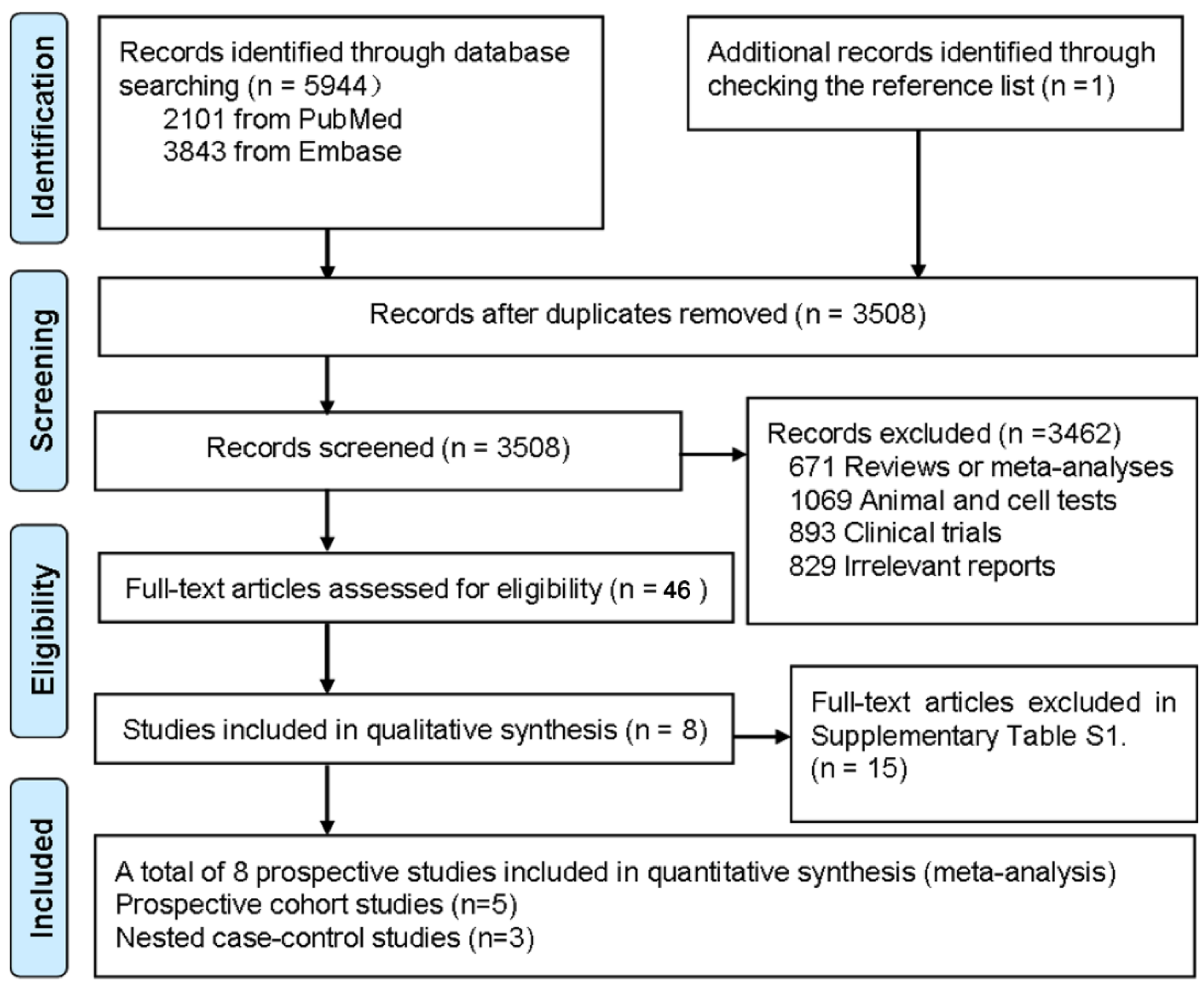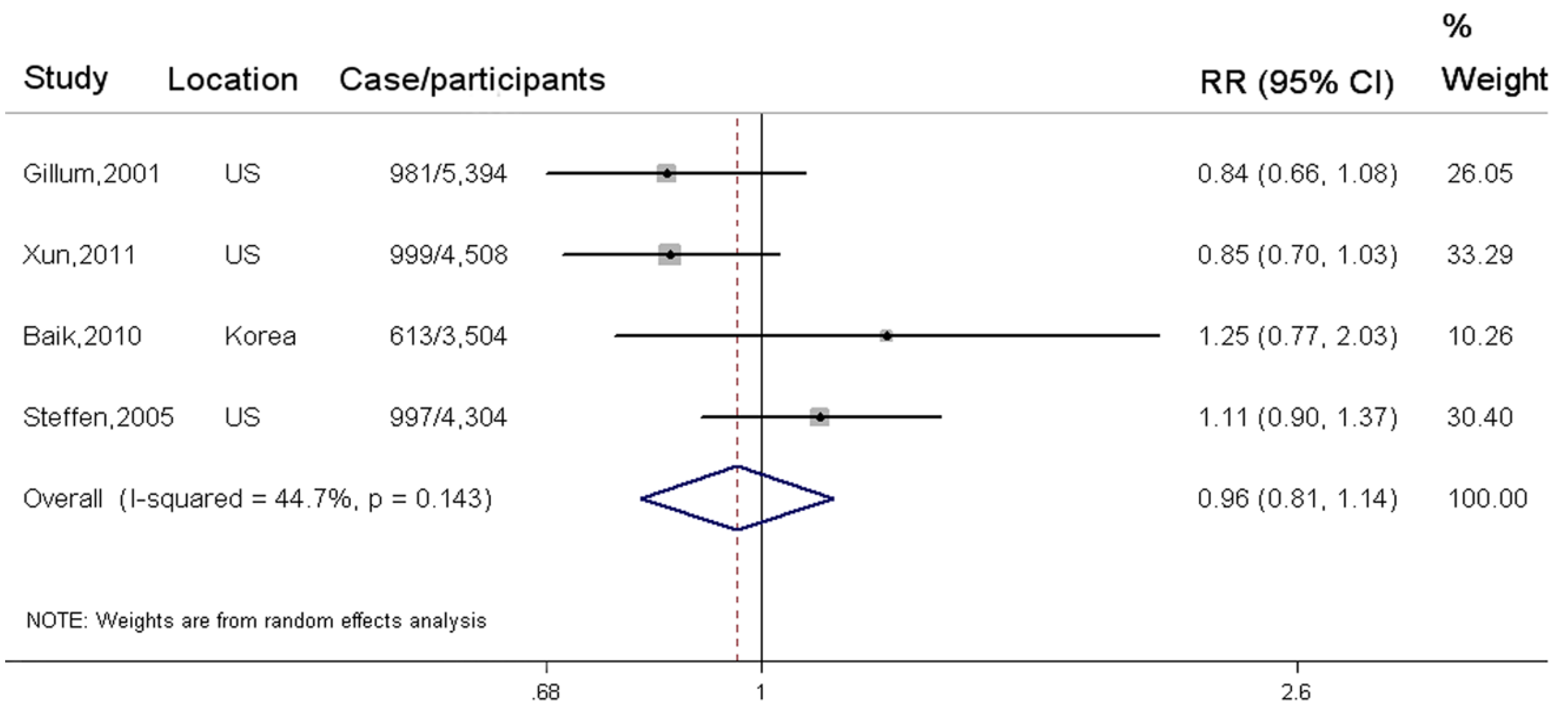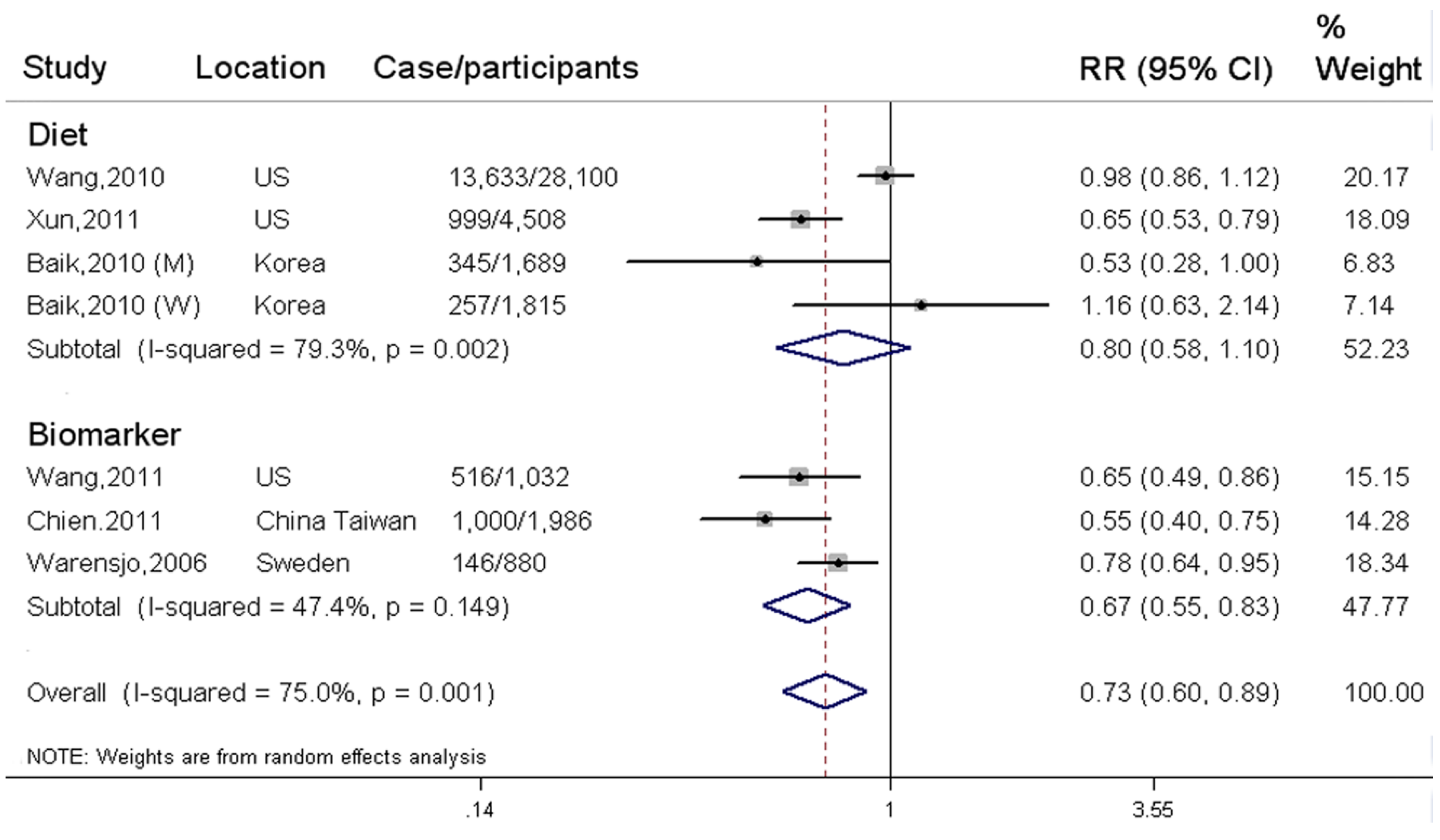Fish, Long-Chain n-3 PUFA and Incidence of Elevated Blood Pressure: A Meta-Analysis of Prospective Cohort Studies
Abstract
:1. Introduction
2. Methods
2.1. Literature Research
2.2. Eligibility Criteria
2.3. Data Extraction
2.4. Statistic Analysis
3. Results
3.1. Literature Search

3.2. Baseline Characteristics
| Ref. | No. of Case/Participants | Age Range, Gender | Follow-Up Duration (Median) | Baseline Measurement | Outcomes RR (95% CI) | Multiple Adjustments | |
|---|---|---|---|---|---|---|---|
| Exposure Assessment | Exposure Range (H vs. L) | ||||||
| [18] | 999/4508 | 18–30 years, Both | 20 years | LC n-3 (g/day), Fish (servings/day); FFQ | 20:5n-3: ≥0.078 vs.< 0.020 | 0.80 (0.66–0.96) | Age, gender, ethnicity, BMI, physical activity, education, smoking, alcohol consumption, family history of hypertension, dietary intakes of total energy, sodium, and fried fish intake. |
| 22:6n-3: ≥0.096 vs.< 0.023 | 0.45 (0.37–0.55) | ||||||
| LC n-3: ≥0.201 vs. < 0.060 | 0.65 (0.53–0.79) | ||||||
| Fish: ≥1.258 vs.< 0.305 | 0.85 (0.70–1.03) | ||||||
| [19] | 516/1032 | ≥39 years, Female | 12.9 years | Erythrocyte PL (%), GLC | 20:5n-3: Q4 vs. Q1 | 0.69 (0.41–0.73) | Age, race, total energy intake, smoking, alcohol use, exercise, menopause status, postmenopausal hormone use, BMI, history of diabetes, and history of hypercholesterolemia. |
| 22:5n-3: Q4 vs. Q1 | 0.59 (0.34–0.90) | ||||||
| 22:6n-3: Q4 vs. Q1 | 0.70 (0.42–1.18) | ||||||
| LC n-3: Q4 vs. Q1 | 0.65 (0.48–0.96) | ||||||
| [20] | 1000/1986 | 55 ± 10 years, Both | 3 years | Plasma PL (%), GLC | 20:5n-3: ≥0.76 vs.< 0.28 | 0.51 (0.33–0.80) | Age, gender, BMI, smoking, drinking, exercise, LDL cholesterol, systolic and diastolic BP, uric acid, fasting glucose levels and total fat in plasma. |
| 22:6n-3: ≥3.56 vs.<1.97 | 0.59 (0.38–0.92) | ||||||
| [16] | 13,633/28,100 | ≥39 years, Female | 12.9 years | LC n-3 (g/day); FFQ | 20:5n-3: Q5 vs. Q1 | 1.01 (0.93–1.08) | Age, race, total energy intake, drug treatment, smoking, alcohol intake, physical activity, postmenopausal status, hormone use, dietary sodium, potassium, calcium, fiber, BMI, history of diabetes, and history of hypercholesterolemia. |
| 22:6n-3: Q5 vs. Q1 | 1.07 (1.01–1.13) | ||||||
| [30] | 613/3504 | 40–69 years, Male and Female. | 3.5 years | LC n-3 (g/day), fish (servings/week); FFQ | LC n-3: Q4 vs. Q1 | 0.79 (0.51–1.23) | Age, BMI, income, occupation, marital status, education level, smoking, alcohol intake, physical activity, daily intake of energy, fat, fiber, red meat, dairy products, sweetened carbonated beverages, use of multivitamin supplements, and diabetes or hypertension. |
| Fish: 5–6 vs.<1 | 1.25 (0.77–2.03) | ||||||
| [31] | 146/880 | 50–70 years, Male | 20 years | Serum (%), GLC | LC n-3: mean (SD) in noncases (1.45 (0.81)) | 0.74 (0.62–0.89) | BMI, smoking, and exercise. |
| [17] | 997/4304 | 18–30 years, Both | 15 years | Fish (times/week); dietary questionnaires | Fish: >2.5 vs.<0.6 | 1.11 (0.90, 1.38) | Age, sex, race, center, energy intake, education, physical activity, alcohol intake, smoking, and vitamin supplement. |
| [29] | 981/5394 | 25–74 years, Both | 10 years | Fish (times/week), FFQ | Fish: ≥1 vs. <1 | 0.84 (0.66, 1.08) | Age, smoking, history of diabetes, education, systolic BP, serum cholesterol, BMI, pulse rate, alcohol intake, and physical activity. |
3.3. Fish Consumption and Elevated BP

3.4. LC n-3 PUFA and Elevated BP

4. Discussion
Supplementary Materials
Acknowledgments
Author Contributions
Conflicts of Interests
References
- Van den Born, B.J. Blood Pressure Lowering and Cardiovascular Risk. Lancet 2014, 384, 1746. [Google Scholar] [CrossRef]
- Muntner, P.; Whittle, J.; Lynch, A.I.; Colantonio, L.D.; Simpson, L.M.; Einhorn, P.T.; Levitan, E.B.; Whelton, P.K.; Cushman, W.C.; Louis, G.T.; et al. Visit-to-Visit Variability of Blood Pressure and Coronary Heart Disease, Stroke, Heart Failure, and Mortality: A Cohort Study. Ann. Intern. Med. 2015, 163, 329–338. [Google Scholar] [CrossRef] [PubMed]
- Del Brutto, O.H.; Mera, R.M.; Gillman, J.; Castillo, P.R.; Zambrano, M.; Ha, J.E. Dietary Oily Fish Intake and Blood Pressure Levels: A Population-Based Study. J. Clin. Hypertens. 2015. [Google Scholar] [CrossRef] [PubMed]
- Colussi, G.; Catena, C.; Dialti, V.; Pezzutto, F.; Mos, L.; Sechi, L.A. Fish Meal Supplementation and Ambulatory Blood Pressure in Patients with Hypertension: Relevance of Baseline Membrane Fatty Acid Composition. Am. J. Hypertens. 2014, 27, 471–481. [Google Scholar] [CrossRef] [PubMed]
- Cabo, J.; Alonso, R.; Mata, P. Omega-3 Fatty Acids and Blood Pressure. Br. J. Nutr. 2012, 107, S195–S200. [Google Scholar] [CrossRef] [PubMed]
- Morris, M.C.; Sacks, F.; Rosner, B. Does Fish Oil Lower Blood Pressure? A Meta-Analysis of Controlled Trials. Circulation 1993, 88, 523–533. [Google Scholar] [CrossRef] [PubMed]
- Miller, P.E.; van Elswyk, M.; Alexander, D.D. Long-Chain Omega-3 Fatty Acids Eicosapentaenoic Acid and Docosahexaenoic Acid and Blood Pressure: A Meta-Analysis of Randomized Controlled Trials. Am. J. Hypertens. 2014, 27, 885–896. [Google Scholar] [CrossRef] [PubMed]
- Geleijnse, J.M.; Giltay, E.J.; Grobbee, D.E.; Donders, A.R.; Kok, F.J. Blood Pressure Response to Fish Oil Supplementation: Metaregression Analysis of Randomized Trials. J. Hypertens 2002, 20, 1493–1499. [Google Scholar] [CrossRef] [PubMed]
- Campbell, F.; Dickinson, H.O.; Critchley, J.A.; Ford, G.A.; Bradburn, M. A Systematic Review of Fish-Oil Supplements for the Prevention and Treatment of Hypertension. Eur. J. Prev. Cardiol. 2013, 20, 107–120. [Google Scholar] [CrossRef] [PubMed]
- Van Den Elsen, L.W.; Spijkers, L.J.; van Den Akker, R.F.; van Winssen, A.M.; Balvers, M.; Wijesinghe, D.S.; Chalfant, C.E.; Garssen, J.; Willemsen, L.E.; Alewijnse, A.E.; et al. Dietary Fish Oil Improves Endothelial Function and Lowers Blood Pressure Via Suppression of Sphingolipid-Mediated Contractions in Spontaneously Hypertensive Rats. J. Hypertens. 2014, 32, 1050–1058. [Google Scholar] [CrossRef] [PubMed]
- Ogawa, A.; Suzuki, Y.; Aoyama, T.; Takeuchi, H. Dietary Alpha-Linolenic Acid Inhibits Angiotensin-Converting Enzyme Activity and Mrna Expression Levels in the Aorta of Spontaneously Hypertensive Rats. J. Oleo Sci. 2009, 58, 355–360. [Google Scholar] [CrossRef] [PubMed]
- Begg, D.P.; Puskas, L.G.; Kitajka, K.; Menesi, D.; Allen, A.M.; Li, D.; Mathai, M.L.; Shi, J.R.; Sinclair, A.J.; Weisinger, R.S. Hypothalamic Gene Expression in Omega-3 Pufa-Deficient Male Rats Before, and Following, Development of Hypertension. Hypertens. Res. 2012, 35, 381–387. [Google Scholar] [CrossRef] [PubMed]
- Pauletto, P.; Puato, M.; Caroli, M.G.; Casiglia, E.; Munhambo, A.E.; Cazzolato, G.; Bittolo Bon, G.; Angeli, M.T.; Galli, C.; Pessina, A.C. Blood Pressure and Atherogenic Lipoprotein Profiles of Fish-Diet and Vegetarian Villagers in Tanzania: The Lugalawa Study. Lancet 1996, 348, 784–788. [Google Scholar] [CrossRef]
- Bountziouka, V.; Polychronopoulos, E.; Zeimbekis, A.; Papavenetiou, E.; Ladoukaki, E.; Papairakleous, N.; Gotsis, E.; Metallinos, G.; Lionis, C.; Panagiotakos, D. Long-Term Fish Intake Is Associated with Less Severe Depressive Symptoms among Elderly Men and Women: The Medis (Mediterranean Islands Elderly) Epidemiological Study. J. Aging Health 2009, 21, 864–880. [Google Scholar] [CrossRef] [PubMed]
- Ke, L.; Ho, J.; Feng, J.; Mpofu, E.; Dibley, M.J.; Feng, X.; van, F.; Leong, S.; Lau, W.; Lueng, P.; et al. Modifiable Risk Factors Including Sunlight Exposure and Fish Consumption Are Associated with Risk of Hypertension in a Large Representative Population from Macau. J. Steroid Biochem. Mol. Biol. 2014, 144, 152–155. [Google Scholar] [CrossRef] [PubMed]
- Wang, L.; Manson, J.E.; Forman, J.P.; Gaziano, J.M.; Buring, J.E.; Sesso, H.D. Dietary Fatty Acids and the Risk of Hypertension in Middle-Aged and Older Women. Hypertension 2010, 56, 598–604. [Google Scholar] [CrossRef] [PubMed]
- Steffen, L.M.; Kroenke, C.H.; Yu, X.; Pereira, M.A.; Slattery, M.L.; van Horn, L.; Gross, M.D.; Jacobs, D.R., Jr. Associations of Plant Food, Dairy Product, and Meat Intakes with 15-Y Incidence of Elevated Blood Pressure in Young Black and White Adults: The Coronary Artery Risk Development in Young Adults (Cardia) Study. Am. J. Clin. Nutr. 2005, 82, 1169–1177. [Google Scholar] [PubMed]
- Xun, P.; Hou, N.; Daviglus, M.; Liu, K.; Morris, J.S.; Shikany, J.M.; Sidney, S.; Jacobs, D.R.; He, K. Fish Oil, Selenium and Mercury in Relation to Incidence of Hypertension: A 20-Year Follow-Up Study. J. Intern. Med. 2011, 270, 175–186. [Google Scholar] [CrossRef] [PubMed]
- Wang, L.; Tsai, M.; Manson, J.E.; Djousse, L.; Gaziano, J.M.; Buring, J.E.; Sesso, H.D. Erythrocyte Fatty Acid Composition Is Associated with the Risk of Hypertension in Middle-Aged and Older Women. J. Nutr. 2011, 141, 1691–1697. [Google Scholar] [CrossRef] [PubMed]
- Chien, K.L.; Chao, C.L.; Kuo, C.H.; Lin, H.J.; Liu, P.H.; Chen, P.R.; Hsu, H.C.; Lee, B.C.; Lee, Y.T.; Chen, M.F. Plasma Fatty Acids and The Risk of Metabolic Syndrome in Ethnic Chinese Adults in Taiwan. Lipids Health Dis. 2011, 10, 33. [Google Scholar] [CrossRef] [PubMed]
- He, K.; Song, Y.; Daviglus, M.L.; Liu, K.; van Horn, L.; Dyer, A.R.; Goldbourt, U.; Greenland, P. Fish Consumption and Incidence of Stroke: A Meta-Analysis of Cohort Studies. Stroke 2004, 35, 1538–1542. [Google Scholar] [CrossRef] [PubMed]
- Dersimonian, R.; Laird, N. Meta-Analysis in Clinical Trials. Control Clin. Trials 1986, 7, 177–188. [Google Scholar] [CrossRef]
- Higgins, J.P.; Thompson, S.G.; Deeks, J.J.; Altman, D.G. Measuring Inconsistency in Meta-Analyses. BMJ 2003, 327, 557–560. [Google Scholar] [CrossRef] [PubMed]
- Egger, M.; Davey Smith, G.; Schneider, M.; Minder, C. Bias in Meta-Analysis Detected by a Simple, Graphical Test. BMJ 1997, 315, 629–634. [Google Scholar] [CrossRef] [PubMed]
- Zheng, J.; Huang, T.; Yu, Y.; Hu, X.; Yang, B.; Li, D. Fish Consumption and CHD Mortality: An Updated Meta-Analysis of Seventeen Cohort Studies. Public Health Nutr. 2012, 15, 725–737. [Google Scholar] [CrossRef] [PubMed]
- Jackson, D.; White, I.R.; Thompson, S.G. Extending Dersimonian and Laird's Methodology to Perform Multivariate Random Effects Meta-Analyses. Stat. Med. 2010, 29, 1282–1297. [Google Scholar] [CrossRef] [PubMed]
- Orsini, N.; Bellocco, R.; Greenland, S. Generalized Least Squares for Trend Estimation of Summarized Dose-Response Data. Stata J. 2006, 6, 40–57. [Google Scholar]
- Orsini, N.; Li, R.; Wolk, A.; Khudyakov, P.; Spiegelman, D. Meta-Analysis For Linear and Nonlinear Dose-Response Relations: Examples, an Evaluation of Approximations, and Software. Am. J. Epidemiol. 2012, 175, 66–73. [Google Scholar] [CrossRef] [PubMed]
- Gillum, R.F.; Mussolino, M.E.; Madans, J.H. Fish Consumption and Hypertension Incidence in African Americans and Whites: The Nhanes I Epidemiologic Follow-Up Study. J. Natl. Med. Assoc. 2001, 93, 124–128. [Google Scholar] [PubMed]
- Baik, I.; Abbott, R.D.; Curb, J.D.; Shin, C. Intake of Fish and N-3 Fatty Acids and Future Risk of Metabolic Syndrome. J. Am. Diet. Assoc. 2010, 110, 1018–1026. [Google Scholar] [CrossRef] [PubMed]
- Warensjo, E.; Sundstrom, J.; Lind, L.; Vessby, B. Factor Analysis of Fatty Acids in Serum Lipids as a Measure of Dietary Fat Quality in Relation to the Metabolic Syndrome in Men. Am. J. Clin. Nutr. 2006, 84, 442–448. [Google Scholar] [PubMed]
- Kim, Y.S.; Xun, P.; He, K. Fish Consumption, Long-Chain Omega-3 Polyunsaturated Fatty Acid Intake and Risk of Metabolic Syndrome: A Meta-Analysis. Nutrients 2015, 7, 2085–2100. [Google Scholar] [CrossRef] [PubMed]
- Skog, K. Cooking Procedures and Food Mutagens—A Literature-Review. Food Chem. Toxicol. 1993, 31, 655–675. [Google Scholar] [CrossRef]
- Kupferschmidt, K. Epidemiology. Report Reignites Battle over Low-Salt Diets. Science 2013, 340, 908. [Google Scholar] [CrossRef] [PubMed]
- Andersen, L.F.; Solvoll, K.; Drevon, C.A. Very-Long-Chain N-3 Fatty Acids as Biomarkers for Intake of Fish and N-3 Fatty Acid Concentrates. Am. J. Clin. Nutr. 1996, 64, 305–311. [Google Scholar] [PubMed]
- Hjartaker, A.; Lund, E.; Bjerve, K.S. Serum Phospholipid Fatty Acid Composition and Habitual Intake of Marine Foods Registered by A Semi-Quantitative Food Frequency Questionnaire. Eur. J. Clin. Nutr. 1997, 51, 736–742. [Google Scholar] [CrossRef] [PubMed]
- Kuriki, K.; Nagaya, T.; Tokudome, Y.; Imaeda, N.; Fujiwara, N.; Sato, J.; Goto, C.; Ikeda, M.; Maki, S.; Tajima, K.; et al. Plasma Concentrations of (N-3) Highly Unsaturated Fatty Acids Are Good Biomarkers of Relative Dietary Fatty Acid Intakes: A Cross-Sectional Study. J. Nutr. 2003, 133, 3643–3650. [Google Scholar] [PubMed]
- Harris, W.S.; Pottala, J.V.; Sands, S.A.; Jones, P.G. Comparison of the Effects of Fish and Fish-Oil Capsules on the n 3 Fatty Acid Content of Blood Cells and Plasma Phospholipids. Am. J. Clin. Nutr. 2007, 86, 1621–1625. [Google Scholar] [PubMed]
- Mori, T.A.; Watts, G.F.; Burke, V.; Hilme, E.; Puddey, I.B.; Beilin, L.J. Differential Effects of Eicosapentaenoic Acid and Docosahexaenoic Acid on Vascular Reactivity of the Forearm Microcirculation in Hyperlipidemic, Overweight Men. Circulation 2000, 102, 1264–1269. [Google Scholar] [CrossRef] [PubMed]
- Leaf, A.; Kang, J.X.; Xiao, Y.F.; Billman, G.E. Clinical Prevention Of Sudden Cardiac Death by N-3 Polyunsaturated Fatty Acids and Mechanism of Prevention of Arrhythmias by N-3 Fish Oils. Circulation 2003, 107, 2646–2652. [Google Scholar] [CrossRef] [PubMed]
- Mori, T.A.; Bao, D.Q.; Burke, V.; Puddey, I.B.; Beilin, L.J. Docosahexaenoic Acid But Not Eicosapentaenoic Acid Lowers Ambulatory Blood Pressure and Heart Rate In Humans. Hypertension 1999, 34, 253–260. [Google Scholar] [CrossRef] [PubMed]
- Mclennan, P.L. Myocardial Membrane Fatty Acids and the Antiarrhythmic Actions of Dietary Fish Oil in Animal Models. Lipids 2001, 36, S111–S114. [Google Scholar] [CrossRef] [PubMed]
- Grynberg, A.; Fournier, A.; Sergiel, J.P.; Athias, P. Effect of Docosahexaenoic Acid and Eicosapentaenoic Acid in the Phospholipids of Rat Heart Muscle Cells on Adrenoceptor Responsiveness and Mechanism. J. Mol. Cell. Cardiol. 1995, 27, 2507–2520. [Google Scholar] [CrossRef] [PubMed]
- Santulli, G.; Cipolletta, E.; Sorriento, D.; del Giudice, C.; Anastasio, A.; Monaco, S.; Maione, A.S.; Condorelli, G.; Puca, A.; Trimarco, B.; et al. Camk4 Gene Deletion Induces Hypertension. J. Am. Heart Assoc. 2012, 1, E001081. [Google Scholar] [CrossRef] [PubMed]
- Hashimoto, M.; Shinozuka, K.; Gamoh, S.; Tanabe, Y.; Hossain, M.S.; Kwon, Y.M.; Hata, N.; Misawa, Y.; Kunitomo, M.; Masumura, S. The Hypotensive Effect of Docosahexaenoic Acid Is Associated with the Enhanced Release of Atp from the Caudal Artery of Aged Rats. J. Nutr. 1999, 129, 70–76. [Google Scholar] [PubMed]
© 2016 by the authors; licensee MDPI, Basel, Switzerland. This article is an open access article distributed under the terms and conditions of the Creative Commons by Attribution (CC-BY) license (http://creativecommons.org/licenses/by/4.0/).
Share and Cite
Yang, B.; Shi, M.-Q.; Li, Z.-H.; Yang, J.-J.; Li, D. Fish, Long-Chain n-3 PUFA and Incidence of Elevated Blood Pressure: A Meta-Analysis of Prospective Cohort Studies. Nutrients 2016, 8, 58. https://doi.org/10.3390/nu8010058
Yang B, Shi M-Q, Li Z-H, Yang J-J, Li D. Fish, Long-Chain n-3 PUFA and Incidence of Elevated Blood Pressure: A Meta-Analysis of Prospective Cohort Studies. Nutrients. 2016; 8(1):58. https://doi.org/10.3390/nu8010058
Chicago/Turabian StyleYang, Bo, Mei-Qi Shi, Zi-Hao Li, Jian-Jun Yang, and Duo Li. 2016. "Fish, Long-Chain n-3 PUFA and Incidence of Elevated Blood Pressure: A Meta-Analysis of Prospective Cohort Studies" Nutrients 8, no. 1: 58. https://doi.org/10.3390/nu8010058
APA StyleYang, B., Shi, M.-Q., Li, Z.-H., Yang, J.-J., & Li, D. (2016). Fish, Long-Chain n-3 PUFA and Incidence of Elevated Blood Pressure: A Meta-Analysis of Prospective Cohort Studies. Nutrients, 8(1), 58. https://doi.org/10.3390/nu8010058





